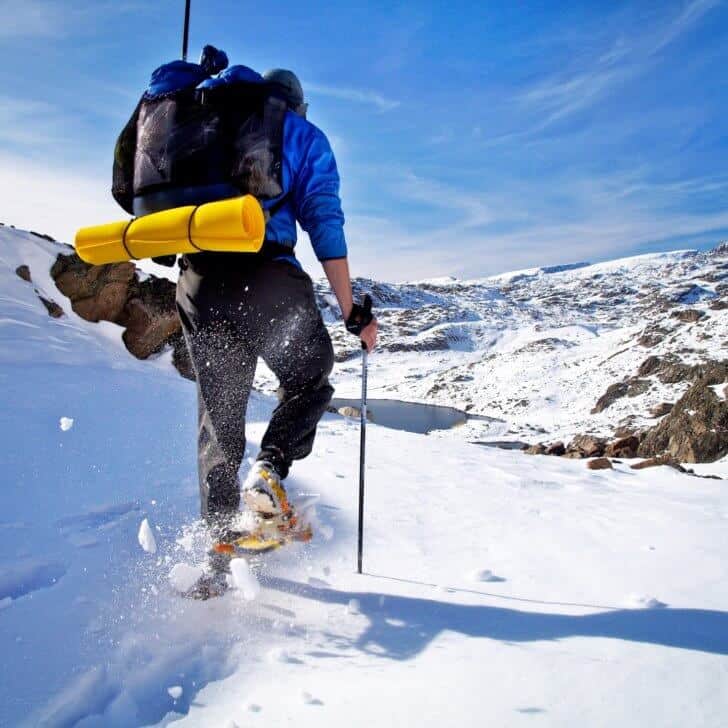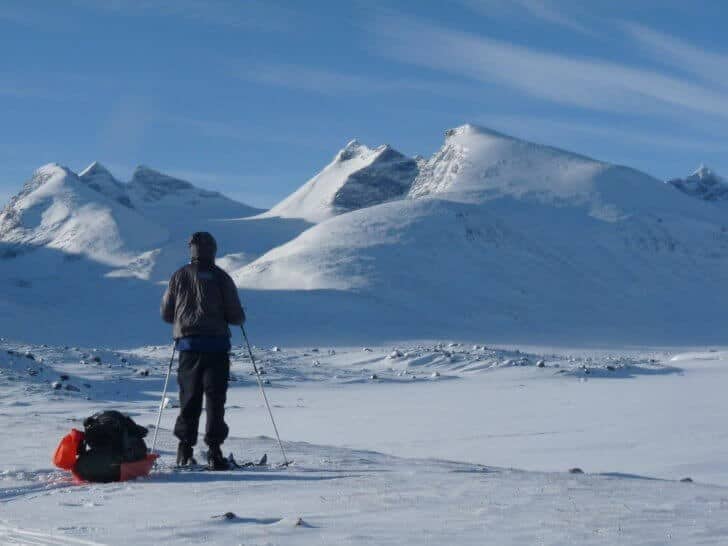
Editor’s Introduction
For some, winter backpacking is an uncomfortable endeavor – it’s challenging and rewarding and perhaps, not for everybody. Many would-be winter backpackers suffer through their first trip in freezing misery and suffering from carrying a pack full of heavy “winter” gear. It doesn’t have to be this way. Lightweight backpacking in the winter is a realistic activity that simply requires some additional practice and intentionality with how you select and use your gear, and how you make decisions during inclement conditions.
This guide teaches you how to go lightweight backpacking in the winter, so you can travel and camp safely and comfortably in the cold and snow without carrying an absurd amount of weight.
The rewards of going out in the winter are worth the cost required to learn the skills, select the gear, and practice. Winter affords silence, solitude, natural beauty, personal rewards, and an emotional connection to the backcountry that are incomprehensible to the summer hiker.
I first met Jörgen when he attended Backpacking Light’s first Wilderness Adventures Guide Training in October 2007, when we attempted a very snowy and wintry crossing of the Beartooth Plateau in Montana. One of the unique constraints to that trek was that I gave the guides- and instructors-in-training a map that was missing its contour lines – the map only contained only a handful of key visual landmarks, so the participants were required to navigate their way across this complex, convoluted mountain range using little more than intuition and occasional triangulation.
I distinctly remember Jörgen being one of the calmest and most collected people I’ve ever had the pleasure of hiking with, even when we encountered deep snow, sketchy avalanche conditions, and difficult navigation. It was clear to me then that Jörgen was naturally comfortable in winter conditions, and to have him be able to create this terrific guide to lightweight backpacking the winter for us is a real treat.
Spending a year in the army in northern Sweden, Jörgen logged wilderness miles in the Arctic areas of northern Europe. He has spent some 150 nights in snow and freezing temperatures since then. This article takes you through the gear and techniques he has used, mostly for tundra camping north of the Arctic Circle.
This is not a short read: 12,000+ words describe the systems that Jörgen has considered, and used, to ensure that he’s safe and comfortable in a wide variety of winter conditions.
– Ryan Jordan, Backpackinglight.com Founder / Publisher
Outline: Lightweight Backpacking in the Winter
- Winter Backcountry Travel: Defined
- What is Snow? Density, Depth, and Surface Hardness
- Winter Tundra: Exposure
- Winter Forest: Unconsolidated Snow
- Wind = Temperature Chill
- Winter Storms: Should I Stop or Should I Go?
- Winter Temperatures: Length of Days and Latitudes
- Multi-Day Trips: Managing Gear for Exposed Camping over Long Periods
- Other Info About Winter Backpacking at BPL
- Preparing for Winter Travel: It’s All in the Mind (Maybe)
- Lightweight Techniques for Winter Travel
- Clothing: Can’t You Just Add One More Insulating Layer to Your Summer Clothing System?
- Maintain Comfort While Hiking in Cold and Inclement Conditions: Minimizing Moisture Buildup
- Upper Body
- Lower Body
- Head and Hands
- Feet
- How to Stay Warm During Breaks and in Camp
- Maintain Comfort While Hiking in Cold and Inclement Conditions: Minimizing Moisture Buildup
- Shelter & Sleep Systems
- How to Stay Protected from Winter Storms in Camp: Selecting a Shelter
- Commentary on Snow Shelters and Their Relevance for Winter Travel
- Why It’s Critical to Create a “System” for Sleeping for Winter Backpacking
- Case Study: My Multi-Day Winter Sleep System
- Packing Systems: Transporting Your Winter Gear Efficiently and with a Minimum of Energy
- Traction Systems: How to Get Anywhere in Any Type of Snow
- Hydration and Culinary Arts: Selecting and Using Winter Stoves
- Staying Hydrated: A Simple System for Maintaining High Water Intake During Cold Weather
- Clothing: Can’t You Just Add One More Insulating Layer to Your Summer Clothing System?
- Commentary on Winter Backpacking Gear: Saving Weight
- Selecting a Pack Large Enough to Hold Your Winter Gear
- Layering the Sleep Systems: Integrate Your Summer Gear into Your Winter Systems
- Winter Shelters for Most Conditions Can Weigh Less than 2.5 lb
- Cooking Systems in the Winter: Extra Fuel Weight, or Extra Stove Weight?
- Considering Weight in Your Clothing System: Minimize the Cost of Moisture Mangement and Insulation, But Don’t Neglect Their Importance…
- Transportation Systems: Weight on Your Feet vs. Efficiency of Oversnow Travel
- How Much Extra Weight Will I Really Carry on a Winter Backpacking Trek?
- Now, It’s Time to Get Out There!
- My Winter Backpacking Gear List

Winter Backcountry Travel: Defined
Member Exclusive
A Premium or Unlimited Membership* is required to view the rest of this article.
* A Basic Membership is required to view Member Q&A events




Home › Forums › Lightweight Backpacking in the Winter: Gear and Techniques from the Arctic